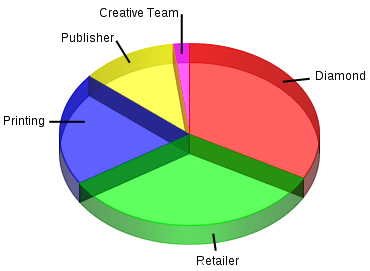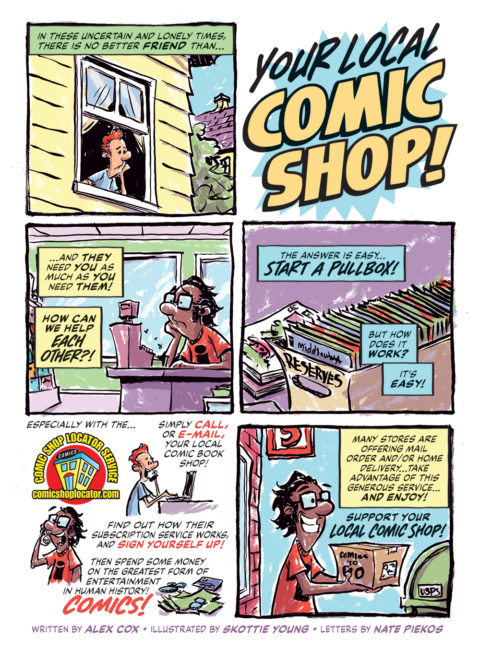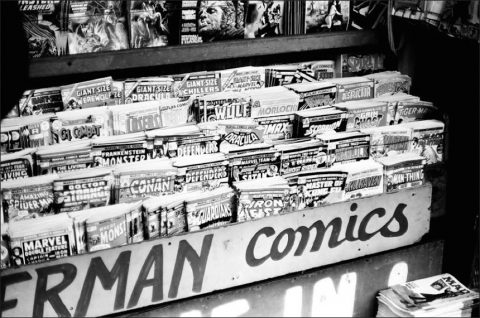This week saw an insightful post from Skullkickers’ writer Jim Zub about the realities of comic publishing costs and profits. Basically after all other costs there’s very little left for the creators.
On a print run of 5000 comics (and many, many creator-owned titles sell less than that in the current market), it means $1250 to $2500 remains for those 4 important categories. Guess how that breaks down?
If the advertising cost was ZERO and publisher expenses were ZERO, then the writer and artist of a 20 page comic would still only get $31.25 to $62.50 EACH PER PAGE. Oops, no money in there for the cover art, sorry. Add in more people (inker, colorist, letterer, etc) and the amount would get split even further, but this is a BOGUS number. The publisher has expenses/staff to pay.
The reality is that once the publisher takes their share of what’s left (and they absolutely deserve it), there’s actually no money left for the creative team, let alone advertising.
This prompted retailer Kevin Boyd, owner of The Comic Book Lounge, to write on Facebook about pre-orders. This is exactly the kind of article we’d love to have up Kevin.
Preorders help us determine the minimum number of copies we should order of the next available issue (usually two down the line), and FOC is crucial for this as well, as it allows us to adjust our numbers of the one in-between. If a new book comes out and I order 5 number 1s, and I have one preorder, I’m watching the other 4 carefully. If at the end of the week I’m left with 4 copies, I slash my order for the next issue. If I’m sold out I need to consider bumping my order of the next one.
So hand in hand small press comics and retailers are working to get these books out to the comic reading public.
You may be asking yourself “why do I care about what profit comic creators make or how well my local comic shop does”, and if that’s the case you’re an idiot. Marvel and DC are for the most part producing capes in tights comics, month in and month out. If you like comics outside of that very narrow genre then you’re most likely buying and reading comics from small press publishers.
Trade paperback and graphic novel readers may be wondering why they should worry about these scenarios, and the simple fact is that the current comics production system works by producing a 22 page comic serially and then collecting them in a book format. There are no advances for graphic novelists from comic publishers, therefore most comic creators need a regular paycheck like the rest of us and can only afford to work on a long comic in between regular paying jobs.
Read online previews and put in pre-orders at your local comic shop; help out everyone in the production line by letting them know you want their comic.





I must say I’m surprised at the size of retailers’ chunk. Now I know why Walt is wearing a new gold tooth and platinum necklace every time I see him.
The real criminal is Diamond, at least in the pie-chart you’ve posted (which is quite different than the updated one in the link you included, where their cut is only about 1/6). That’s why we have (had) laws against monopolies.
“You may be asking yourself “why do I care about what profit comic creators make or how well my local comic shop does”, and if that’s the case you’re an idiot.” Boom.
There was some (incorrect, I’d say) ruling in the US years ago that because you can buy trades from Chapters or Borders type stores there is no monopoly.
The missing piece to the pie is that by selling advertising some costs are offset, but we have seen a large drop in ads (and therefore profits) in the last decade.
The other point is that each individual comic isn’t really treated on its own by a company. Some comics may technically lose money, and some make generate more revenue than is necessary to simply keep the next issue going. Creators are paid their rate before the comic hits the stands and don’t (necessarily) see increased profits if a books sells extraordinarily well. The model in many ways mimics a movie studio. The actors have already been paid by the time a movie hits the theatres and only very few will see a percentage of gross profit.
Moral of the story is as Jim and Scott say, make your pre-orders, support small press and creator owned work, support your local comic shop, and when you enjoy a book tell everyone you know about it.
I would also point out that my movie studio comparison only works for the larger companies like Marvel and DC. Yet another reason to support indy works.
My challenge now is balancing the support with the desire to move to trades. I pre-ordered and bought the first couple issues of Saga, but once I decided I liked it, I stopped and will be going trades only. I’ve bought a lot of stuff twice over the years and just can’t afford to keep playing that game. I think I’ve bought BONE 3 or 4 times. Cerebus sorta twice, Echo, Joe/Seth/Chester’s work.
We’re in a period of transition, and it’s not gonna be easy.
Here’s the updated pie chart mentioned.
Despite fan sites like CBD who like to build up creative as being celebs… I’ve always said that the business model resembles factory work more then art. For every Frank Miller, there are thousands who are hoping to make next months rent.
Consider the music industry, toy designers, Walmart… and take a real close look at even Hollywood. Why would the print industry be any different? The economies of scale is that distribution always take the lions share and people who make minimum wage are not motivated to do more than the bare minimum…
The retail piece of the pie is misleading considering that most stores in TO offer member discounts and that 47% is spread across thousands of stores. The creative sliver may seem small but smaller still is the individual retail sliver that a single store makes from a book.
The secret sauce to all this is licensing. The idea is to get your stuff out there, any way you can but just make sure you retain the licensing rights.
Sadly you are right, and that merch thing goes across all levels. From the lowly small presser who sells shirts and buttons to make money the sale of comics and trades doesn’t bring in, to the Hasbro Avengers tie-in toys. It would be nice to live off the story and art, but the numbers just don’t support it.
The 47% is what each store makes off of each comic (they buy comics from DIamond at around 53% of cover) but that whole 47% isn’t profit. Of that 47% a whole new pie could be created for retailers showing all their costs (staff, rent, etc.) that might demonstrate an average profit for each book. And if a store offers a discount it eats into their profit line with the hope that the increase in sales will result in a greater overall profit (often not the case).
If I order 5 and sell all 5 issues of a $2.99 comic, in theory I’ve made back our $7.50 investment in the product (in theory as we have other costs in the product like shipping) and earned the same $7.50 amount back that goes towards paying our monthly expenses (staffing, rent, other bills). However, if I order 5, if I don’t sell 3 copies for $9, then I’ve lost money. Every retailer has to consider making sure there is product for walk-in customers, but over ordering and sitting on unsold product can really hurt a small business, which is why we need to know you want it (i.e. preorders).